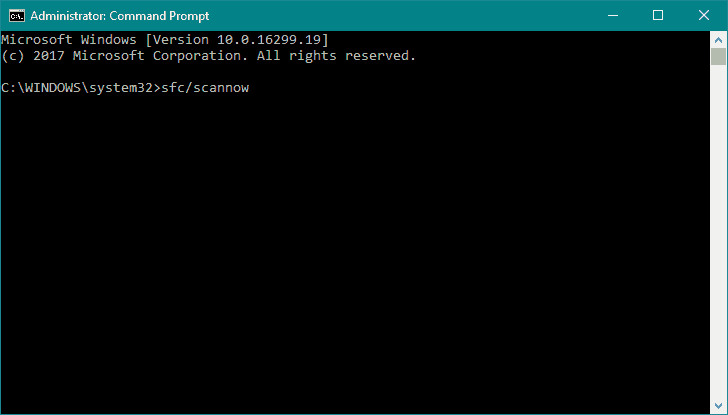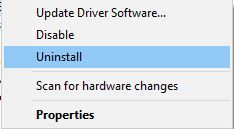Fix: PAGE_FAULT_IN_FREED_SPECIAL_POOL error in Windows 10
8 min. read
Updated on
Read our disclosure page to find out how can you help Windows Report sustain the editorial team Read more

Blue Screen of Death errors such as PAGE_FAULT_IN_FREED_SPECIAL_POOL are often caused by hardware issues, and they can be rather serious. Since these errors will restart your PC every time they appear, it’s crucial that you know how to fix these errors on Windows 10.
How to fix PAGE_FAULT_IN_FREED_SPECIAL_POOL BSoD error
Table of contents:
- Update Windows 10 and your drivers
- Run the Hardware Troubleshooter
- Run the SFC scan
- Run DISM
- Remove problematic software
- Remove overclock settings
- Reset Windows 10
- Check your hardware
Fix – PAGE_FAULT_IN_FREED_SPECIAL_POOL Windows 10 error
1. Update Windows 10 and your drivers
Many operating systems have certain issues with hardware and software, and Windows 10 is no exception. Usually some older hardware or software isn’t fully compatible with Windows 10, and that can cause a Blue Screen of Death error to appear and restart your PC. In order to avoid Blue Screen of Death errors it’s recommended that you use Windows Update frequently and download the latest patches. Microsoft is frequently releasing new patches, and many of these patches address both hardware and software issues, therefore if you’re having problems with BSoD errors be sure to update Windows 10.
In addition to downloading Windows updates it’s also important that you keep your drivers updated. Drivers are a key component that allows Windows 10 to recognize and utilize certain hardware, and if your driver is outdated or buggy you’ll encounter a PAGE_FAULT_IN_FREED_SPECIAL_POOL Blue Screen of Death error.
In order to fix this problem you’ll have to update all your drivers, so be sure to visit your hardware manufacturer’s website and download the latest drivers for your hardware. Many users reported that this issue was fixed after updating their chipset drivers, so be sure to update them first and then move to other major components.
Update drivers automatically
Searching for drivers on your own can be time-consuming. So, we advise you to use a tool that will do this for you automatically. Using an automatic driver updater will certainly save you from the hassle of searching for drivers manually, and it will always keep your system up to date with the latest drivers.
Advanced softwares will help you update drivers automatically and prevent PC damage caused by installing the wrong driver versions. After several tests, our team concluded that this is the best-automatized solution.
- Download and install Outbyte Driver Updater.
- Launch the software.
- Wait for the app to detect all faulty drivers.
- Now, it will show you all the malfunctioning drivers listed to select the ones to Update or Ignore.
- Click on Update & Apply Selected to download and install the newest versions.
- Restart your PC to ensure the applied changes.

Outbyte Driver Updater
Secure your Windows PC with Outbyte from various errors caused by problematic drivers.2. Run the Hardware Troubleshooter
Now, we’re going to turn to Windows 10’s own troubleshooting tools. The first tool we’re going to seek help from is the ‘unified’ troubleshooter. This tool can be used for dealing with various problems, including the BSOD issues.
Here’s how to run the BSOD troubleshooter in Windows 10:
- Open the Settings app and go to Update & Security section.
- Select Troubleshoot from the menu on the left.
- Select BSOD from the right pane and click Run the troubleshooter.
- Follow the instructions on the screen to complete the troubleshooter.
3. Run the SFC scan
The SFC scan is a command-line tool that basically scans your computer for potential errors, and resolves them if the solution is available. Among other errors that the SFC scan can help with are the BSOD issues.
Here’s how to run the SFC scan in Windows 10:
- Right-click on the Start Menu button, and open Command Prompt (Admin).
- Enter the following line and press Enter: sfc/scannow
- Wait until the process is done (it may take a while).
- If the solution is found, it will automatically be applied.
- Now, close the Command Prompt and restart your computer.
4. Run DISM
And the third troubleshooter we’re going to use is DISM. Deployment Image Servicing and Management (DISM) is a powerful tool that reloads the system image. So, it can also resolve potential BSOD errors.
We’ll walk you through both standard and the procedure that utilizes the installation media below:
- Standard way
- Right-click Start and open Command Prompt (Admin).
- Paste the following command and press Enter:
- Wait until the scan is finished.
- Restart your computer and try updating again.
- With the Windows installation media
- Insert your Windows installation media.
- Right-click the Start menu and, from the menu, choose the Command Prompt (Admin).
- In the command line, type the following commands and press Enter after each:
- dism /online /cleanup-image /scanhealth
- dism /online /cleanup-image /restorehealth
- Now, type the following command and press Enter:
- DISM /Online /Cleanup-Image /RestoreHealth /source:WIM:X:SourcesInstall.wim:1 /LimitAccess
- Make sure to change an X value with the letter of the mounted drive with Windows 10 installation.
- After the procedure is finished, restart your computer.
5. Remove problematic software
Blue Screen of Death errors can be caused by software, and in order to fix this problem you’ll have to find and remove the problematic software from your PC. Most common cause for BSoD errors is your antivirus, and if you want to fix this error you’ll have to remove all third-party antivirus programs that you have installed.
- READ ALSO: Fix: Wdf_violation BSoD error on Windows 10
Bear in mind that antivirus programs tend to leave certain files and registry entries behind after you uninstall them, therefore you’ll need to use dedicated removal tool to remove any files associated with your antivirus program. Many antivirus companies have these tools available for download, so be sure that you download them. Users reported issues with Norton Antivirus, but bear in mind that almost any antivirus program can cause PAGE_FAULT_IN_FREED_SPECIAL_POOL error to appear.
Although antivirus is the often cause for these errors, you should know that almost any application can cause this error to appear. According to users, they had issues with Extreme Tune, and after removing it, the BSoD error was fixed. It’s worth mentioning that some drivers can cause this issue to appear, and users reported that old printer drivers caused this error. If the driver is causing this issue, you can remove it by following these steps:
- Press Windows Key + X to open Power User Menu and select Device Manager from the list.
- When Device Manager opens find the problematic driver, right click it and choose Uninstall.
- After removing the driver restart your PC.
When your PC restarts, Windows 10 will install the default driver. If the error doesn’t appear again, it means that the faulty driver was the problem. You can continue using the default driver or you can update it, but be sure not to install the same problematic version.
6. Remove overclock settings
By using overclocking software you can change the default settings of your hardware in order to get better performance. Overclocking is an advanced procedure and by overclocking your hardware you can cause permanent damage to your PC if you’re not careful. In addition to permanent damage, overclocking can cause PAGE_FAULT_IN_FREED_SPECIAL_POOL Blue Screen of Death error to appear, and in order to fix this problem you need to disable all overclock settings.
- READ ALSO: Fix Error ‘0x80240031c’ On Windows 10
7. Reset Windows 10
If the PAGE_FAULT_IN_FREED_SPECIAL_POOL error is caused by software, you can fix it by performing Windows 10 reset. You should know that this procedure is similar to clean install, therefore it’s necessary that you back up your files because this process will delete all files from your C partition. We have to mention that you might need a bootable USB flash drive with Windows 10 to complete this step, so be sure to create one by using Media Creation Tool. To perform Windows 10 reset do the following:
- Restart your PC while it boots. Repeat this step few times until you start Automatic Repair.
- Choose Troubleshoot > Reset this PC > Remove everything. You might get asked to insert Windows 10 installation media, so be ready to do that.
- Choose Only the drive where Windows is installed > Just remove my files and click the Reset button.
- Follow the steps and complete the reset procedure.
Once you finish Windows 10 reset, check if the problem is resolved. If the BSoD error appears again, it’s most likely that certain hardware component is causing this error.
8. Check your hardware
PAGE_FAULT_IN_FREED_SPECIAL_POOL can be caused by faulty hardware, most commonly RAM, so be sure to test your RAM modules one by one until you find the faulty one. According to users, the error was fixed after finding and replacing the faulty RAM module, but if your RAM is working properly check all other hardware components.
PAGE_FAULT_IN_FREED_SPECIAL_POOL Blue Screen of Death error can cause many problems, but we hope that our solutions helped you fix this error.
READ ALSO:














